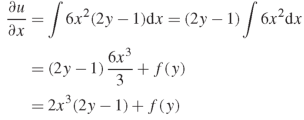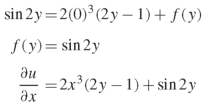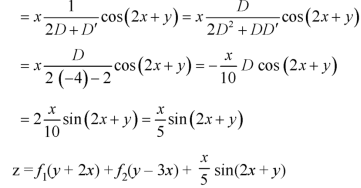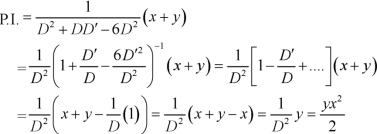Question Bank
Module–3
Partial differential equations
Question-1: Form a partial differential equation from-

Sol.
Here we have-

It contains two arbitrary constants a and c
Differentiate the equation with respect to p, we get-

Or

Now differentiate the equation with respect to q, we get-


Now eliminate ‘c’,
We get

Now put z-c in (1), we get-

Or

Question-2: Solve-

Sol.
Here we have-

Integrate w.r.t. x, we get-

Integrate w.r.t. x, we get-


Integrate w.r.t. y, we get-

Question-3: Solve the differential equation-

Given the boundary condition that-
At x = 0, 
Sol.
Here we have-

On integrating partially with respect to x, we get-

Here f(y) is an arbitrary constant.
Now form the boundary condition-
When x = 0,

Hence-

On integrating partially w.r.t.x, we get-

Question-4: Solve the differential equation-

Given that  when y = 0, and u =
when y = 0, and u =  when x = 0.
when x = 0.
Sol.
We have-

Integrating partially w.r.t. y, we get-

Now from the boundary conditions, 
Then-

From which,

It means,

On integrating partially w.r.t. x givens-


From the boundary conditions, u =  when x = 0
when x = 0


From which-

Therefore the solution of the given equation is-

Question-5: Find the general solution of-

Sol. The auxiliary simultaneous equations are-
 ……….. (1)
……….. (1)
Using multipliers x, y, z we get-
Each term of (1) is equals to-

Xdx + ydy + zdz=0
On integrating-
 ………… (2)
………… (2)
Again equation (1) can be written as-

Or


 ………….. (3)
………….. (3)
From (2) and (3), the general solution is-

Question-6: Solve-

Sol.
This equation can be transformed as-


 ………. (1)
………. (1)
Let


Equation (1) can be written as-
 ………… (2)
………… (2)
Let the required solution be-

From (2) we have-

Question-7: Solve-

Sol.
Let-

That means-

Put these values of p and q in

Question-9; Solve-

Sol.
Here we have-

Auxiliary equation will be-

C.F.-

P.I.-

Here

This is the case of failure.
Now-


Question-10: Solve-

Sol.
This equation can be written as-

Writing D = m and D’ = 1, then the auxiliary equation will be-

m = -3, 2
C.F.-


Hence the complete solution is-
